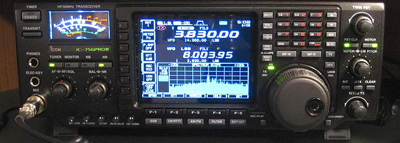 |
 |
The IC-756Pro III received FCC certification on September 9, 2004 under FCC ID AFJ217800.
Icom unveiled the new IC-756Pro III at Tokyo HamFair 2004, which took place on August 21 and 22, 2004.
The IC-756Pro III incorporated the following changes as compared to the IC-756Pro II:
The IC-756PRO III will incorporate some IC-7800 technology:
5 MHz (60m) band standard on all versions. (5 assigned channels open on USA version; band can be enabled on other versions with modification.)
Achieves IP3 > +30 dBm (14MHz band standard value). Refer to 1.1 below.
Employs new diodes and coils in the RF BPF to decrease strong-signal IMD.
Uses a low-noise feedback circuit for Preamp 1. This is a noise-free negative-feedback circuit for Preamp 1, which improves linearity at the expense of power gain, without degrading noise figure. This feedback will increase the 3rd-order intercept point and IMD3 dynamic range without loss of sensitivity when Preamp 1 is engaged.
Employs new quad-JFET first mixer. The strong-signal performance of the mixer and its peripheral circuits is greatly improved.
Uses a fundamental-type SMD monolithic crystal filter as the first roofing filter. The fundamental-type crystal filter, as opposed to a filter using 3rd- or 5th-overtone crystals, will have a better shape factor and be less susceptible to intermodulation under strong-signal conditions. Daishinku is the filter supplier. View a typical filter data sheet.
Greatly improved Noise Reduction performance. (Reported by several new IC-756Pro III owners.)
Much-improved CW QSK. The initial element truncation above 20 wpm has been eliminated. (Reported by several new IC-756Pro III owners.)
Improved protection of RX-ANT input.
1.1 More on receiver performancePaolo Odone I1ODP has measured IP3 on his IC-756Pro III, using two crystal-controlled test-signal sources. The results obtained are presented here. |
The IC-756 Pro II spectrum scope display occupies the lower half of the screen. The IC-756Pro III provides a selectable mini-scope display mode. This allows simultaneous display of the filter, memory-keyer and other menus along with a half-size spectrum-scope display.
IC-756 Pro II: No. IC-756Pro III: Yes (USA versions only).
IC-756 Pro II: No. IC-756Pro III: Yes.
IC-756 Pro II: No. IC-756Pro III: Yes. The new "@" symbol is provided even with the memory keyer enabled.
The IC-756 Pro II provides three selectable TOBW settings: WIDE/MID/NAR. The lower and upper-6dB points of the transmitted audio-frequency response are fixed for each setting.
In the IC-756Pro III, it will be possible to program each of the three settings individually with the following preset cutoff frequencies:
Lower -6dB point: 100, 300 and 500 Hz.
Upper -6dB point: 2.5, 2.7 and 2.9 kHz.
This will permit the operator to configure his own custom WIDE/MID/NAR selections by "mixing & matching" low and high roll-off points. In conjunction with the bass/treble equalisation menu (also offered in the IC-756Pro II), this new feature offers great flexibility in configuring transmit audio.
(Editor's Note: No, Geraldine, there is no "secret menu" to extend the upper audio-frequency limit beyond 2.9 kHz!)
IC-756 Pro II: No. IC-756Pro III: Yes.
IC-756 Pro II: No. IC-756Pro III: Yes.
IC-756 Pro II: No. IC-756Pro III: Yes. The IC-756Pro III will offer a screen saver similar to that incorporated in the first IC-7800 firmware upgrade.
The feature enhancements in the IC-756 Pro III (Items 2 - 8) are incremental with respect to the IC-756Pro II. There is no change in appearance or basic operation as compared to the Pro II.
Unlike the IC-7800, the IC-756Pro III does not offer firmware upgrade capability.
The IC-756Pro III is not fitted with a port for the connection of an external TFT monitor.
Some U.S. dealers are offering the IC-756Pro III at under $3000. The Canadian dealer price is under CAD 3300. European dealers are quoting prices in the €3100 range.
The information presented on this page is preliminary and subject to change. It may be speculative in nature. No responsibility is assumed for its accuracy, or for the consequences of its use.
ARRL IC-756Pro3 Product Review (QST, March 2005 - members only)
The new IC-756Pro3 MOSFET PA Unit
IC-756Pro3 vs. IC-756Pro2 - a presentation given at the North Shore ARC, North Vancouver BC, 1/19/2006
IC-756Pro3 User Manual and Pictures
Paolo, I1ODP's IC-756Pro3 Dynamic Tests
Sources acknowledged with thanks:
https://www.cqcqde.com/shopping/kotei/ic-756pro3.htm (includesa User Report)![]()
cqcqde.com User Report (in English)
eHam IC-756Pro3 User Reviews
Dave, N9EWO's Radio Receiver Page
John Rippey, W3ULS'IC-756Pro3 User Review [Previous Review]
Don Hill, AA5AU'sIC-756Pro III Page andRTTY Twin Peak Filter Page
Transverter operationwith the IC-756Pro3 (and its predecessors)
Never apply positive ALC voltage to the IC-756Pro III.
The IC-756Pro III now has a MOSFET PA Unit.
IC-756Pro2/3 LCD Display Replacement
DXing.info: an SWL perspective on the IC-756Pro III
Use Quick Split and Dual Watch to your advantage
AGC in the IC-756Pro3, IC-7600, IC-7700 and IC-7800.
IC-756Pro3/Quadra ALC overshoot test
Is your IC-756Pro3 or Pro2 running hot?Not really.
The IC-7600 (successor to the IC-756Pro III)
Last updated: December 04, 2021.
Page created on Microsoft SharePoint Designer 2007 by A. Farson VA7OJ/AB4OJ.